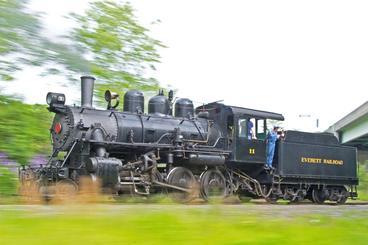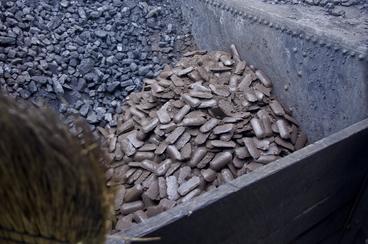Steam locomotives built the America we know today. And fossil coal powered those economic engines of change. But more change is coming.
This summer, NRRI’s torrefied solid biofuel – a roasted, wood-based briquette product – was tested on a full size, 1920’s steam locomotive at the Everett Railroad in Hollidaysburg, Pennsylvania. Ultimately, the goal is to develop a clean biofuel to supplant fossil coal to reduce carbon and heavy metal emissions while minimizing smoke. In order to keep the train fireman happy, it also has to store and shovel like coal and generate enough heat to keep the pressure up. The results were promising.
“It burned with plenty of heat to keep up steam with minimal, if no, additional effort compared to shoveling coal,” said Zach Hall, Everett Railroad steam foreman. “It lights quickly and burns hot.”
This is NRRI’s first step in demonstrating pretreatment of biomass that can lead to a full portfolio of carbon-based products – from bio-based fuels to higher value materials that sequester carbon.
NRRI’s partnership with the Coalition for Sustainable Rail made this unique test possible. NRRI has been working to develop this solid fuel for more than 10 years, testing a variety of biomass sources and binders to perfect the product. In the Everett No. 11 trials, briquettes of 100 percent torrefied biomass fuel and a 50/50 blend of biomass fuel with fossil coal were both tested.
“We were generally pleased with the results of each type of fuel,” said Don Fosnacht, NRRI associate director for the Energy Management Group. “We’re still working to minimize embers in the emissions by testing different binders and briquette sizes.”
There are about 200 historic steam trains in the U.S. – about 150 burn coal – hauling a couple million people per year. The folks who are passionate about running the locomotives are concerned about finding a reliable source of high-quality coal that meets their specifications. Smoke pollution is an environmental concern and distasteful to the tourists who ride the trains.
“Large amounts of visible smoke are something that we must be very mindful of in the areas we operate,” said Foreman Hall. “The ability to test this alternative fuel is exciting for us as we seek modern ways to help keep historic railroading alive for generations to come.”
NRRI is also working with the Coalition for Sustainable Rail to convert old railroad ties into solid biofuel to impact a waste problem for the rail industry. According to the Railway Tie Association, some 4 million crossties are landfilled each year. The initial lab-scale tests yielded promising results. Funds are being sought to scale up the research.
The biomass fuels were also recently tested in a coal-fired blacksmith forge with success. These niche markets for a coal replacement represent first step markets for the innovative product.


